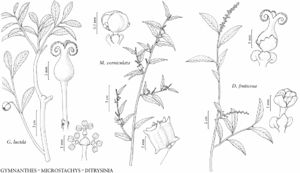Difference between revisions of "Microstachys corniculata"
Fl. Brit. W. I., 49. 1859.
FNA>Volume Importer |
FNA>Volume Importer |
||
| Line 22: | Line 22: | ||
|name=Sebastiania corniculata | |name=Sebastiania corniculata | ||
|authority=(Vahl) Müller Arg. | |authority=(Vahl) Müller Arg. | ||
| − | }}{{Treatment/ID/Synonym | + | }} {{Treatment/ID/Synonym |
|name=Stillingia corniculata | |name=Stillingia corniculata | ||
|authority=(Vahl) Baillon | |authority=(Vahl) Baillon | ||
| Line 40: | Line 40: | ||
|elevation=0–40 m. | |elevation=0–40 m. | ||
|distribution=Fla.;Mexico;West Indies;Central America;South America. | |distribution=Fla.;Mexico;West Indies;Central America;South America. | ||
| − | |discussion=<p>Microstachys corniculata is a weedy species that is adventive and becoming established in Hillsborough County. It has the potential to become broadly naturalized across subtropical parts of the United States. Because this species is widespread in the West Indies, including Cuba, a 1906 collection from Key West may represent a native occurrence.</p> | + | |discussion=<p><i>Microstachys corniculata</i> is a weedy species that is adventive and becoming established in Hillsborough County. It has the potential to become broadly naturalized across subtropical parts of the United States. Because this species is widespread in the West Indies, including Cuba, a 1906 collection from Key West may represent a native occurrence.</p> |
|tables= | |tables= | ||
|references= | |references= | ||
| Line 65: | Line 65: | ||
|publication year=1859 | |publication year=1859 | ||
|special status=Introduced;Selected by author to be illustrated | |special status=Introduced;Selected by author to be illustrated | ||
| − | |source xml=https://jpend@bitbucket.org/aafc-mbb/fna-data-curation.git/src/ | + | |source xml=https://jpend@bitbucket.org/aafc-mbb/fna-data-curation.git/src/8f726806613d60c220dc4493de13607dd3150896/coarse_grained_fna_xml/V12/V12_51.xml |
|genus=Microstachys | |genus=Microstachys | ||
|species=Microstachys corniculata | |species=Microstachys corniculata | ||
Revision as of 14:47, 18 September 2019
Herbs, to 0.5 m, sparsely to moderately hirsute. Stems erect. Leaves: stipules triangular to rounded, 0.2–0.4 mm; petiole 0.1–1.5 cm; blade 2–4.5 × 0.3–2 cm, base cuneate to cordate, margins serrulate with proximal teeth occasionally replaced by orbicular glands, apex acute to acuminate. Inflorescences: staminate portion on peduncle 1–2 mm, fertile part 0.5–1.5 cm, to 15 bracts and cymules, flowers 1–3 per bract; pistillate portion with 1 flower; bracts triangular, 0.2 mm, subtended by 2 stipitate glands to 0.2 mm diam. Pedicels 0–0.2 mm, pistillate to 1 mm in fruit. Staminate flowers: sepals red-purple to greenish yellow, ovate, 0.3–0.5 mm; stamens yellow; filaments 0.2–0.3; anthers 0.2 mm. Pistillate flowers green; sepals ovate, 0.2–0.5 mm; ovary bearing short horned appendages; styles 0.3–0.6 mm. Capsules subglobose, 3–4 mm diam.; horned appendages 2–3 per valve, to 1 mm. Seeds 3 × 2 mm; seed coat brown, warty; caruncle discoid, 0.5–0.8 mm diam., stipitate on projection of seed coat.
Phenology: Flowering and fruiting summer–fall.
Habitat: Dry, disturbed sandhills.
Elevation: 0–40 m.
Distribution
Fla., Mexico, West Indies, Central America, South America.
Discussion
Microstachys corniculata is a weedy species that is adventive and becoming established in Hillsborough County. It has the potential to become broadly naturalized across subtropical parts of the United States. Because this species is widespread in the West Indies, including Cuba, a 1906 collection from Key West may represent a native occurrence.
Selected References
None.
